Turner Field – until 2016
| Capacity | 50 000 |
|---|---|
| Country | United States of America |
| City | Atlanta |
| Clubs | Atlanta Braves |
| Retire year | 2016 |
| Other names | Centennial Olympic Stadium (1996) |
| Nicknames | The Ted |
| Inauguration | 18/05/1996 |
| Construction | 1993–1996 |
| Renovations | 1996–1997, 2005 |
| Cost | $209 M |
| Design | Atlanta Stadium Design Team (Heery International, Rosser Fabrap International, Williams-Russell & Johnson, Ellerbe Becket) |
| Contractor | Atlanta Stadium Constructors (Beers Construction, HJ Russell Construction, CD Moody Construction) |
Advertisement
Turner Field – historical stadium description
What is Centennial Olympic Stadium / Turner Field in a nutshell?
The stadium, originally known as the Centennial Olympic Stadium, was built for the 1996 Olympic Games in Atlanta as their main venue. It was equipped with an athletics track and stands with a capacity of 85,600 spectators. During the Games, it hosted the opening and closing ceremonies as well as the athletics competitions.
To ensure the stadium's continued use after the Games, it was planned to convert it into a baseball stadium for the MLB team Atlanta Braves. For this reason, the stands behind one of the curves were given a pointed shape, allowing a baseball field to be fitted into this space in the future. Although this made the stadium look rather unusual, it was justified from a practical point of view.
The conversion was carried out immediately after the Olympics, in 1996–1997. In its new baseball configuration, the facility was renamed Turner Field and could accommodate approximately 50,000 spectators. A large video screen was installed next to the outfield stand, which, after modernization in 2005, was for some time the largest HD screen in the world.
The Atlanta Braves played at Turner Field for 20 seasons (1997–2016). After that, the team moved to the new SunTrust Park, built in the northern suburbs of Atlanta.
Turner Field was then taken over by Georgia State University and underwent a second conversion in 2017, this time into an American football venue for the Georgia State Panthers college football team. The stadium was renamed Georgia State Stadium, and after finding a title sponsor in 2020, it became Center Parc Stadium.
The stadium in its latest American football configuration is presented on a separate subpage
How was the Olympic Stadium in Atlanta built?
In 1988, Atlanta was chosen to represent the US in the bid to host the 1996 Olympic Games. Athens was the favorite in the race, as the event was to take place on the 100th anniversary of the first modern Olympic Games, which were held in the Greek capital at the time.
Despite the symbolic significance of Athens, Atlanta gained greater recognition from the International Olympic Committee and was chosen to host the XXVI Olympic Games, also beating four other cities. The selection was made on September 18, 1990.
Atlanta lacked a facility that could serve as the main arena for the Games, so it was decided to build a new one. With a view to using it after the event, the city authorities established cooperation with the Atlanta Braves baseball team (MLB), which had been seeking a new stadium for some time.
Until then, the Braves had played at Atlanta–Fulton County Stadium, located near downtown Atlanta. It was a multi-purpose, circular facility built between 1964 and 1965. The Braves shared it with the Atlanta Falcons American football team, which played in the NFL, although the Falcons were soon to move to the new Georgia Dome.
However, the Braves needed a baseball stadium, while the Games required a facility with an athletics track. This problem was solved in a creative way – the stands behind one of the curves were given the shape of a baseball stadium.
This made it relatively easy to convert the facility into a baseball stadium after the Olympics, ensuring its continued use. At the same time, the arena was given a very original, unusual shape, with an asymmetrical “spike” on the south side.
Who designed the Centennial Olympic Stadium?
The design of the new stadium was prepared by a team of architects (Atlanta Stadium Design Team), which included Heery International, Rosser Fabrap International, Williams-Russell & Johnson, and Ellerbe Becket.
When was Centennial Olympic Stadium built?
The plans for the new facility and its location were revealed in 1992. The facility was to be built on the parking lots next to the existing Atlanta–Fulton County Stadium. Despite opposition from some local residents, construction officially began on July 10, 1993.
The cost of building the stadium was $209 million. This amount was covered entirely by private funds, thanks to money from sponsors. The work was carried out by the Atlanta Stadium Constructors consortium, consisting of Beers Construction, HJ Russell Construction, and CD Moody Construction.
When was Centennial Olympic Stadium inaugurated?
The inauguration of the new Olympic stadium took place two months before the Games, on May 18, 1996, when the Atlanta Grand Prix Track and Field Meet was held there. The venue was opened by Billy Payne, chairman of the organizing committee for the Games, and Al Gore, Vice President of the United States.
From June 14–23, 1996, the new stadium hosted the United States Olympic trials, which served as Olympic qualifiers, as well as the national athletics championships.
What did the Centennial Olympic Stadium look like?
The stadium was intended for athletics, but from the very beginning it was designed in such a way that after the Olympic Games it could be converted into a baseball venue.
That is why the stands behind the southern curve were given an unusual, pointed shape, which did not follow the contour of the running track, but was ideal for fitting a baseball field into them after the Games.
The stands on the south side were permanent and more elaborate – taller, divided into three floors, equipped with boxes and a roof over the upper sections. Their external, monumental walls were finished with brick and limestone.
The stands on the north side, on the other hand, were temporary structures and were intended to be demolished after the Games. The capacity of the stadium in its Olympic athletics configuration was 85,600 spectators.
The auditorium was equipped with dark blue seats, and a large screen was installed above the northern curve. The Olympic torch was placed in the northeast corner, a short distance behind the stands, on the other side of the street, above which ran a footbridge connecting it to the stadium.
Where was the Centennial Olympic Stadium built?
The facility was built near downtown Atlanta, on the parking lots of the Atlanta–Fulton County Stadium, which is why aerial photos from the 1996 Olympics often show two large stadiums standing side by side. The old stadium was also used during the Olympics – it hosted games of the baseball tournament.
In 1997, Atlanta–Fulton County Stadium was demolished (a spectacular implosion took place on August 2), and the site on which it stood was then converted into a parking lot.
The stadium was located right next to Interstate 85, near the junction of Interstates 85 and 20.
What was the course of the 1996 Olympic Games at Centennial Olympic Stadium?
The Olympic Games in Atlanta were held from July 19 to August 4, 1996. Centennial Olympic Stadium served as the main arena for the event, hosting the opening and closing ceremonies as well as the athletics competitions.
During the Games, the Olympic torch stood at Centennial Olympic Stadium, which was lit during the opening ceremony by the famous boxer Muhammad Ali.
During the athletics competitions, the stadium witnessed two world records. The first was set by Canadian Donovan Bailey, who won the 100 m final with a time of 9.84 seconds. The second world record was set by American Michael Johnson, who achieved a time of 19.32 seconds in the 200 m race.
Michael Johnson was one of the biggest stars of these Games, also winning the 400 m race. Frenchwoman Marie-José Pérec also won two gold medals in the 200 m and 400 m races. American Carl Lewis won his ninth Olympic gold medal (at his fourth consecutive Games), winning the long jump competition.
Shortly after the end of the event, the Paralympic Games were also held in Atlanta from August 16–25, 1996. Centennial Olympic Stadium once again served as the main arena for the competition, hosting the opening and closing ceremonies and athletics competitions.
When was the Olympic Stadium in Atlanta converted into a baseball stadium?
In August 1996, immediately after the Paralympics, the stadium was converted into a baseball stadium as planned. The temporary stands in the northern part were demolished, the running track was moved to Panther Stadium, owned by Clark Atlanta University, and the Olympic torch was placed a little further north, where it stands today as a memorial.
New stands were added on the north side, enclosing the baseball field. Along with the new stands, an adjacent building was constructed, which housed the Braves Museum, opened in 1999.
Since the baseball stadium occupied a much smaller area, after the temporary stands in the northern part were removed, a lot of free space remained, which was converted into a large square with additional attractions.
The renovated stadium was inaugurated on March 29, 1997, with an exhibition game between the Braves and the New York Yankees (2–0). The Braves played their first MLB game at the new stadium on April 4, 1997, against the Chicago Cubs (3–4).
What name was given to the Olympic Stadium in Atlanta after its reconstruction?
After its conversion into a baseball facility, the stadium was renamed Turner Field, in honor of media mogul Ted Turner, the founder of CNN, who owned the Atlanta Braves from 1976 to 1996. The stadium soon become colloquially known as The Ted.
Before the new name was given, many fans expected the stadium to be named after Hank Aaron, the legendary Braves player who broke the MLB home run record in 1974.
Who hosted Turner Field?
The stadium replaced the worn-out Atlanta–Fulton County Stadium as the home venue of the Atlanta Braves baseball team (MLB). At the time of the move to the new Turner Field, the Braves were enjoying one of the best periods in their history. The team won consecutive division championships until 2005 and played in the World Series in 1999, where they lost to the New York Yankees.
The Braves were founded in 1870 as the Boston Red Stockings (the name Braves appeared in 1912) and are one of the oldest professional sports teams in the US. Until 1952, the Braves were based in Boston, from 1953 to 1965 the team resided in Milwaukee, and it was not until 1966 that Atlanta became its home.
The Braves, who leased Turner Field, played there for 20 seasons (1997–2016).
What events took place at Turner Field?
In October 1999, the Atlanta Braves participated in the World Series (a series of final games for the MLB league championship), playing against the New York Yankees. The first two games (October 23 and 24) were played at Turner Field, both of which were lost, 1–4 and 2–7, respectively. After two more losses in New York, the New York Yankees won the series.
On July 11, 2000, the stadium hosted the 71st MLB All-Star Game, in which the American League defeated the National League 6–3.
On May 18, 2004, the Atlanta Braves lost 0–2 to the Arizona Diamondbacks at their home stadium. The visiting team's pitcher, 40-year-old Randy Johnson, pitched a perfect game (not allowing any of his opponents to reach base) as the oldest player in MLB history.
On October 5, 2012, Turner Field hosted the National League Wild Card Game (the first edition of what would later become the Wild Card Series). The Braves lost the game to the St. Louis Cardinals 3–6.
The Georgia Tech and University of Georgia college baseball teams have a tradition of playing a series of games against each other every year. Between 2003 and 2016, the highly popular third and final game of this rivalry was held at Turner Field.
Turner Field also hosted music concerts, with George Strait, The Rolling Stones, and Metallica among those who performed at the stadium. The facility also served as a set for various films and TV series.
Three separate fatal accidents involving fans who died after falling from a great height took place at the stadium.
What renovations were carried out at Turner Field?
In 2005, the stadium underwent a $15 million renovation, of which $10 million was spent on a new 78-foot-8-inch by 71-foot-4-inch screen, making it the world's largest high-definition video screen at the time (it was listed in the Guinness Book of World Records).
A second, 1,080-foot-long screen was also installed next to it, mainly used to display scores or advertisements. A new restaurant was also built as part of the stadium renovation.
What were the characteristics of Turner Field?
After the reconstruction carried out after the Olympics, the southern part of the stands was retained – a section that looked rather unusual in an athletics stadium, but was ideal for fitting a baseball field into it.
The preserved, high stands stretched along the foul lines; a small segment on the east side also ran along the outer boundary of the outfield. The stands, which were remnants of the athletics stadium, were three stories high, and their upper sections were covered.
The middle tier of the stands, in the central, curved part around home plate, was entirely occupied by glass-enclosed press and corporate boxes.
Most of the outfield, on the north side, was surrounded by newer stands, built during the reconstruction. They had a rather irregular shape, although they were roughly much lower than those along the foul lines.
A large video screen was placed in the central part (after the 2005 modernization, it was the largest HD video screen in the world for some time), and on the west side, a section was added above the lower level, which was in a sense an extension of the second tier of the west stand.
This superstructure housed additional boxes, and the numbers of former Braves players were displayed on it. One of the most recognizable elements of this part of the stadium was a Coca-Cola advertisement in the form of a large bottle.
In 2008, another distinctive installation appeared next to the Coca-Cola bottle – a huge cow promoting the Chick-fil-A restaurant chain, depicted in a pose performing the famous Braves fan gesture, the Tomahawk Chop.
Part of the premium area in this section of the stadium was an observation deck from which visitors could admire the panorama of downtown Atlanta. The facility offered significantly more VIP space, located in various parts of the stadium. In its baseball configuration, the stadium could seat approximately 50,000 spectators (the capacity varied slightly over the years).
Adjacent to the north stand was a large building housing, among other things, a museum established in 1999 presenting the rich history of the Braves (Ivan Allen Jr. Braves Museum and Hall of Fame). The building, like the outer walls of the older stands, had a brick facade with limestone elements. A large sign with the stadium's name was also placed above the facade.
The museum was integrated with Scouts Alley, a special themed area designed for younger fans and families, offering a wealth of games and activities, interactive zones, and other attractions.
After the demolition of the athletics track and temporary stands built for the Olympics, a large amount of free space remained in the northern part, which was converted into a large square. In the western part of this area, behind the large screen, additional pavilions were built, including a family zone, as well as food outlets and beverage stands. The pavilions formed a semi-enclosed area called Fan Plaza or Grand Entry Plaza.
Most of the plaza was occupied by the so-called Monument Grove, which served as an open-air museum. It featured statues of legendary Braves players, including Hank Aaron, sculptures depicting large baseballs and retired player numbers, as well as the Braves Walk Of Fame, a series of plaques embedded in the sidewalk with the names of distinguished team members.
The outer boundary of the square was marked by a fence with a row of massive columns that once served as supports for the temporary stands of the Olympic stadium.
How did the next renovation of the Olympic Stadium in Atlanta come about?
At the end of the lease period, the Braves team negotiated its extension, but the city did not want to bear the costs of modernizing the stadium, which were estimated at $350 million.
The Braves ultimately decided to build a new facility of their own in the northern suburbs of Atlanta. Thus, SunTrust Park (renamed Truist Park in 2020) was built between 2014 and 2017, becoming the team's new home.
Following the Braves' move, Georgia State University (GSU), whose main campus is located a short distance away in downtown Atlanta, expressed interest in acquiring the facility.
Ultimately, GSU, together with partner development companies, purchased the stadium and surrounding land for $30 million. The university wanted the facility to serve its football team, the Georgia State Panthers, so another renovation of the arena was planned, this time to convert it into a facility for American football.
The Braves' last game (a 1–0 win over the Detroit Tigers) and farewell to the old facility took place on October 2, 2016. The home plate and the distinctive cow promoting the Chick-fil-A restaurant chain were brought over to the new stadium.
The conversion of Turner Field into a college football facility began in late February 2017. The rebuilt arena, now known as Georgia State Stadium, opened in August 2017.
Advertisement
Pictures
2012
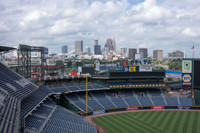
05.09.2012 © Stephen Rahn 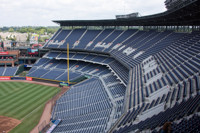
05.09.2012 © Stephen Rahn 
17.07.2012 © Sreejithk2000 (CC BY-SA 3.0)
2011
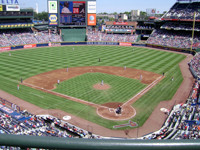
18.09.2011 © Pete (CC BY 2.0) 
14.08.2011 © Jeffrey Hayes (CC BY 2.0) 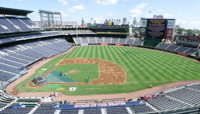
14.08.2011 © Jeffrey Hayes (CC BY 2.0) 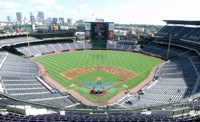
14.08.2011 © Jeffrey Hayes (CC BY 2.0)
2010
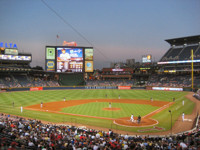
31.08.2010 © (WT-shared) Jtesla16 (CC BY-SA 3.0) 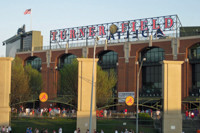
05.04.2010 © terren in Virginia (CC BY 2.0
2009
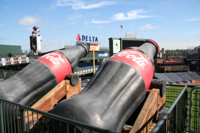
28.10.2009 © Peter Bond (CC BY-SA 2.0) 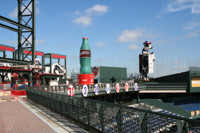
28.10.2009 © Peter Bond (CC BY-SA 2.0) 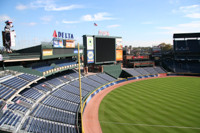
28.10.2009 © Peter Bond (CC BY-SA 2.0)
2008
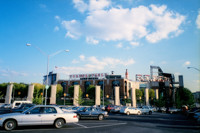
2008 © slayer (CC BY 2.0)
2005
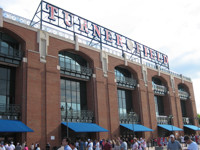
25.05.2005 © Stephen Rahn
1996

1996 © John Sherwell (CC BY-SA 3.0) 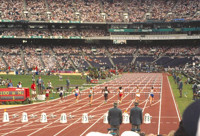
1996 © Dr. Edwin P. Ewing, Jr., Centers for Disease Control and Prevention

 StadiumDB
StadiumDB